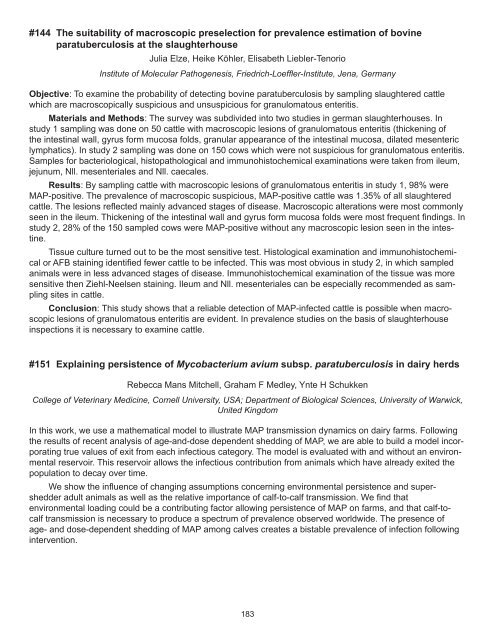Proceedings of the 10th International Colloquium on Paratuberculosis
Proceedings of the 10th International Colloquium on Paratuberculosis
Proceedings of the 10th International Colloquium on Paratuberculosis
You also want an ePaper? Increase the reach of your titles
YUMPU automatically turns print PDFs into web optimized ePapers that Google loves.
#144 The suitability <str<strong>on</strong>g>of</str<strong>on</strong>g> macroscopic preselecti<strong>on</strong> for prevalence estimati<strong>on</strong> <str<strong>on</strong>g>of</str<strong>on</strong>g> bovine<br />
paratuberculosis at <str<strong>on</strong>g>the</str<strong>on</strong>g> slaughterhouse<br />
Julia Elze, Heike Köhler, Elisabeth Liebler-Tenorio<br />
Institute <str<strong>on</strong>g>of</str<strong>on</strong>g> Molecular Pathogenesis, Friedrich-Loeffler-Institute, Jena, Germany<br />
Objective: To examine <str<strong>on</strong>g>the</str<strong>on</strong>g> probability <str<strong>on</strong>g>of</str<strong>on</strong>g> detecting bovine paratuberculosis by sampling slaughtered cattle<br />
which are macroscopically suspicious and unsuspicious for granulomatous enteritis.<br />
Materials and Methods: The survey was subdivided into two studies in german slaughterhouses. In<br />
study 1 sampling was d<strong>on</strong>e <strong>on</strong> 50 cattle with macroscopic lesi<strong>on</strong>s <str<strong>on</strong>g>of</str<strong>on</strong>g> granulomatous enteritis (thickening <str<strong>on</strong>g>of</str<strong>on</strong>g><br />
<str<strong>on</strong>g>the</str<strong>on</strong>g> intestinal wall, gyrus form mucosa folds, granular appearance <str<strong>on</strong>g>of</str<strong>on</strong>g> <str<strong>on</strong>g>the</str<strong>on</strong>g> intestinal mucosa, dilated mesenteric<br />
lymphatics). In study 2 sampling was d<strong>on</strong>e <strong>on</strong> 150 cows which were not suspicious for granulomatous enteritis.<br />
Samples for bacteriological, histopathological and immunohistochemical examinati<strong>on</strong>s were taken from ileum,<br />
jejunum, Nll. mesenteriales and Nll. caecales.<br />
Results: By sampling cattle with macroscopic lesi<strong>on</strong>s <str<strong>on</strong>g>of</str<strong>on</strong>g> granulomatous enteritis in study 1, 98% were<br />
MAP-positive. The prevalence <str<strong>on</strong>g>of</str<strong>on</strong>g> macroscopic suspicious, MAP-positive cattle was 1.35% <str<strong>on</strong>g>of</str<strong>on</strong>g> all slaughtered<br />
cattle. The lesi<strong>on</strong>s reflected mainly advanced stages <str<strong>on</strong>g>of</str<strong>on</strong>g> disease. Macroscopic alterati<strong>on</strong>s were most comm<strong>on</strong>ly<br />
seen in <str<strong>on</strong>g>the</str<strong>on</strong>g> ileum. Thickening <str<strong>on</strong>g>of</str<strong>on</strong>g> <str<strong>on</strong>g>the</str<strong>on</strong>g> intestinal wall and gyrus form mucosa folds were most frequent findings. In<br />
study 2, 28% <str<strong>on</strong>g>of</str<strong>on</strong>g> <str<strong>on</strong>g>the</str<strong>on</strong>g> 150 sampled cows were MAP-positive without any macroscopic lesi<strong>on</strong> seen in <str<strong>on</strong>g>the</str<strong>on</strong>g> intestine.<br />
Tissue culture turned out to be <str<strong>on</strong>g>the</str<strong>on</strong>g> most sensitive test. Histological examinati<strong>on</strong> and immunohistochemical<br />
or AFB staining identified fewer cattle to be infected. This was most obvious in study 2, in which sampled<br />
animals were in less advanced stages <str<strong>on</strong>g>of</str<strong>on</strong>g> disease. Immunohistochemical examinati<strong>on</strong> <str<strong>on</strong>g>of</str<strong>on</strong>g> <str<strong>on</strong>g>the</str<strong>on</strong>g> tissue was more<br />
sensitive <str<strong>on</strong>g>the</str<strong>on</strong>g>n Ziehl-Neelsen staining. Ileum and Nll. mesenteriales can be especially recommended as sampling<br />
sites in cattle.<br />
C<strong>on</strong>clusi<strong>on</strong>: This study shows that a reliable detecti<strong>on</strong> <str<strong>on</strong>g>of</str<strong>on</strong>g> MAP-infected cattle is possible when macroscopic<br />
lesi<strong>on</strong>s <str<strong>on</strong>g>of</str<strong>on</strong>g> granulomatous enteritis are evident. In prevalence studies <strong>on</strong> <str<strong>on</strong>g>the</str<strong>on</strong>g> basis <str<strong>on</strong>g>of</str<strong>on</strong>g> slaughterhouse<br />
inspecti<strong>on</strong>s it is necessary to examine cattle.<br />
#151 Explaining persistence <str<strong>on</strong>g>of</str<strong>on</strong>g> Mycobacterium avium subsp. paratuberculosis in dairy herds<br />
Rebecca Mans Mitchell, Graham F Medley, Ynte H Schukken<br />
College <str<strong>on</strong>g>of</str<strong>on</strong>g> Veterinary Medicine, Cornell University, USA; Department <str<strong>on</strong>g>of</str<strong>on</strong>g> Biological Sciences, University <str<strong>on</strong>g>of</str<strong>on</strong>g> Warwick,<br />
United Kingdom<br />
In this work, we use a ma<str<strong>on</strong>g>the</str<strong>on</strong>g>matical model to illustrate MAP transmissi<strong>on</strong> dynamics <strong>on</strong> dairy farms. Following<br />
<str<strong>on</strong>g>the</str<strong>on</strong>g> results <str<strong>on</strong>g>of</str<strong>on</strong>g> recent analysis <str<strong>on</strong>g>of</str<strong>on</strong>g> age-and-dose dependent shedding <str<strong>on</strong>g>of</str<strong>on</strong>g> MAP, we are able to build a model incorporating<br />
true values <str<strong>on</strong>g>of</str<strong>on</strong>g> exit from each infectious category. The model is evaluated with and without an envir<strong>on</strong>mental<br />
reservoir. This reservoir allows <str<strong>on</strong>g>the</str<strong>on</strong>g> infectious c<strong>on</strong>tributi<strong>on</strong> from animals which have already exited <str<strong>on</strong>g>the</str<strong>on</strong>g><br />
populati<strong>on</strong> to decay over time.<br />
We show <str<strong>on</strong>g>the</str<strong>on</strong>g> influence <str<strong>on</strong>g>of</str<strong>on</strong>g> changing assumpti<strong>on</strong>s c<strong>on</strong>cerning envir<strong>on</strong>mental persistence and supershedder<br />
adult animals as well as <str<strong>on</strong>g>the</str<strong>on</strong>g> relative importance <str<strong>on</strong>g>of</str<strong>on</strong>g> calf-to-calf transmissi<strong>on</strong>. We find that<br />
envir<strong>on</strong>mental loading could be a c<strong>on</strong>tributing factor allowing persistence <str<strong>on</strong>g>of</str<strong>on</strong>g> MAP <strong>on</strong> farms, and that calf-tocalf<br />
transmissi<strong>on</strong> is necessary to produce a spectrum <str<strong>on</strong>g>of</str<strong>on</strong>g> prevalence observed worldwide. The presence <str<strong>on</strong>g>of</str<strong>on</strong>g><br />
age- and dose-dependent shedding <str<strong>on</strong>g>of</str<strong>on</strong>g> MAP am<strong>on</strong>g calves creates a bistable prevalence <str<strong>on</strong>g>of</str<strong>on</strong>g> infecti<strong>on</strong> following<br />
interventi<strong>on</strong>.<br />
183






